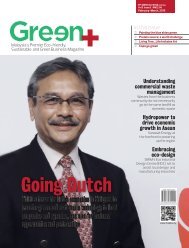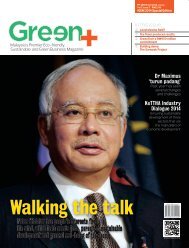Green+ Malaysia's Premier Eco-friendly, Sustainable and Green Business Magazine
SIRIM - Technology Provider
SIRIM - Technology Provider
You also want an ePaper? Increase the reach of your titles
YUMPU automatically turns print PDFs into web optimized ePapers that Google loves.
SCITECH<br />
The ancients are always a<br />
puzzle, whether colonising<br />
Europe or even when<br />
they left Africa <strong>and</strong> bred with<br />
Ne<strong>and</strong>erthals. See the latest<br />
DNA evidence from a Siberian femur<br />
for that one! The genetic reason for this<br />
European success is now becoming<br />
more evident. The colonists developed<br />
advantageous genes, combined with<br />
several other factors based on their<br />
technologies.<br />
The Hungarian Plain has always been<br />
at the centre of European invasions. The<br />
study concerned here used samples of<br />
DNA from skulls dated 5,700 to 800BC.<br />
The late Neolithic led there into the<br />
Copper Age Baden Culture, the early<br />
Bronze Age <strong>and</strong> the early Iron Age as<br />
the Near East, the steppes <strong>and</strong> Central<br />
Europe all swapped technologies.<br />
The Hallstatt Culture began there, in<br />
Transdanubia, with the fabled Scythians<br />
further east on the fertile plain.<br />
Did the invasions bring new people,<br />
or just a few with the requisite technology?<br />
Agriculture provides the answer<br />
here, if we twist around the evidence<br />
to include knowledge of the genomes.<br />
Evidence of Mesolithic hunter gatherers,<br />
like them is scattered here <strong>and</strong> there,<br />
apart from northern Hungary <strong>and</strong> also<br />
to the north. We want to know if these<br />
early settlers intermarried with the<br />
farmers appearing from the south <strong>and</strong><br />
the east.<br />
Genome results show that Neolithic<br />
people has southern Mediterranean,<br />
mainly Sardinian affinities, as has been<br />
found before. Local male hunter gatherers<br />
became incorporated into farming<br />
Our ancient ancestors<br />
couldn’t digest milk<br />
Other genes were found relevant to population changes<br />
communities, but in the 3rd millennium<br />
BC, the Bronze Age must have been<br />
revolutionary. Trade increased <strong>and</strong><br />
heavily fortified settlements grew in<br />
Carpathia <strong>and</strong> its mountain passes.<br />
Only one Iron Age sample was taken<br />
from the Mezőcsát Culture (possibly<br />
pre-Scythian in 830-980 BC.) Asian<br />
Credit: © Shutterstock<br />
influence is obvious here, probably from<br />
the steppes. Technology then involved<br />
horse domestication, carts, chariots<br />
<strong>and</strong> the obvious metallurgies. Today’s<br />
Hungarians have more western genome<br />
affinities, presumable due to mixing of<br />
European populations since then.<br />
The real excitement of this mixture<br />
Birds run carefully in the rough<br />
Placing feet in the right place<br />
concerns robots <strong>and</strong> runners,<br />
<strong>and</strong> almost all bipeds <strong>and</strong><br />
tetrapods. Here is an article<br />
of interest to in Runners. The<br />
UKs Royal Veterinary College<br />
(<strong>and</strong> Oregon State University)<br />
have often studied small<br />
crouching creatures <strong>and</strong> large<br />
upright birds such as ostrich.<br />
The mass of these birds ranges<br />
from 0.2kg to 117kg, so the<br />
strategy for movement could<br />
be extremely varied.<br />
Aleks<strong>and</strong>ra Birn-Jeffrey,<br />
Monica Daley <strong>and</strong> 4 colleagues<br />
published their findings in the<br />
science journal JEB as Don’t<br />
break a leg: running birds<br />
from quail to ostrich prioritise<br />
leg safety <strong>and</strong> economy on<br />
uneven terrain. Being bipedal,<br />
stability of the body seemed<br />
likely to be a priority, but the<br />
maintenance of consistent<br />
forces from the running<br />
legs was found to be more<br />
important. <strong>Eco</strong>nomy in terms<br />
of energy expended <strong>and</strong> the<br />
safety of the legs turned out<br />
to be major results of that<br />
consistent running mode, no<br />
matter how uneven the ground<br />
was.<br />
When birds first flew,<br />
it would have given them<br />
ecological advantages. If<br />
take-off speed was a precursor,<br />
however, then running in<br />
a stable manner could have<br />
influenced avian evolution too.<br />
The stability of the animal does<br />
seem to be a control priority for<br />
many species.<br />
As all birds are dynamically<br />
similar as they approach a step<br />
obstacle (from 0.1 to 0.5 times<br />
their leg length), the leap they<br />
make onto the object seems<br />
to be followed by a crouch that<br />
keeps them stable there. The<br />
forces exerted in the procedure<br />
showed up how they negotiated<br />
the steps. They all jump off<br />
with extended legs.<br />
Some ostriches used in<br />
the experimental work had to<br />
be reared from chicks for two<br />
years, so that their imprinting<br />
on humans could be used to<br />
decrease any aggression <strong>and</strong><br />
enable h<strong>and</strong>ling. These big<br />
guys were expected to vault<br />
upward <strong>and</strong> then immediately<br />
step down, but every bird<br />
performed the basic crouch on<br />
top of the step.<br />
With an Oregon University<br />
computer model, the runners<br />
could be modelled exactly.<br />
They discovered two alternative<br />
task level priorities. The<br />
68<br />
november-december, green+.2014





